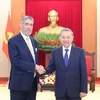 Soldiers at the Vinh Xuong International Border Gate in An Giang province patrol a border route. (Photo: VNA)
Soldiers at the Vinh Xuong International Border Gate in An Giang province patrol a border route. (Photo: VNA) Hanoi (VNA) –Vietnam always wishes to work together with neighbouring countries to build common borders of peace, friendship, cooperation and development, said Deputy Prime Minister and Foreign Minister Pham Binh Minh.
The wish is in line with Vietnam’s foreign policy of independence, self-reliance, peace, cooperation and development and serves the target of maintaining a peaceful and stable environment for national development, the official said in an article which was published following a conference in Hanoi on October 5 to review land border demarcation and marker planting work of Vietnam and Cambodia during the 2006-2019 period.
A borderline clearly marked in the field and recognised in internationally valid legal documents will facilitate the management of and ensure national defence and security in border areas, contributing to socio-economic development as well as exchanges, friendship and cooperation between neighbouring countries, Minh noted.
The Deputy PM and FM highlighted the time-honoured relationship between Vietnam and Cambodia, saying apart from consolidating and enhancing the friendship and cooperation, the two sides have always affirmed their respect for independence, sovereignty, territorial integrity as well as legitimate rights of each other, not intervention in each other’s internal affairs, equality and mutual benefits.
Over the past 40 years, thanks to joint great and tireless efforts, issues left over by history between the two sides, including those regarding border and territory, have been addressed actively.
The border between Vietnam and Cambodia was formed since feudal time, but the delimitation stopped at the boundaries among regions. Under the colonial regime, the border was adjusted by the Governor-General of Indochina.
After the French withdrew from Indochina in 1954, the entire border was drawn relatively completely on the Bonne map 1/100,000 published by the Indochinese department of geography.
Between 1954 and 1977, Vietnam and Cambodia held some negotiations on border issues, which, however, produced no outcome. Following the birth of the People’s Republic of Kampuchea (PRK), the two countries signed the Treaty of Peace, Friendship and Cooperation between the Socialist Republic of Vietnam (SRV) on February 18, 1979.
On the basis of the treaty, they negotiated and sealed the Treaty on the Principles for Border Issues Resolution between the SRV and the PRK on July 20, 1983, and the Treaty on the Demarcation of National Boundaries between the SRV and the PRK on December 27, 1985.
In implementing the 1985 treaty, the two sides began to conduct boundary demarcation and border marker planting in 1986, with 322 markers planned to be erected. However, the work was suspended in early 1989. In 1999, the negotiation on land border was resumed and the two countries inked the Supplementary Treaty to the 1985 treaty between the SRV and the Kingdom of Cambodia, known in short as the 2005 Supplementary Treaty, on October 10, 2005.
Accordingly, they adjusted the border line in some areas and reached consensus on the implementation of border demarcation and marker planting along the entire route.
To materialise the 1985 treaty and 2005 supplementary treaty, in 2006, Vietnam and Cambodia resumed land border delimitation and marker planting. In 2013, they concurred to plant auxiliary markers and poles to further clarify the border line in the field.
By now, the two sides have demarcated about 1,045km of the border line and built 2,047 markers at 4,553 positions in the field, or around 84 percent of the workload along the entire border line.
The outcomes of the work have been detailed in the two state-level international treaties signed by Vietnam and Cambodia in Hanoi on October 5, 2019, which are the Supplementary Treaty to the 1985 Treaty on the Delimitation of National Boundaries and the Supplementary Treaty to the 2005 treaty (known in short as the 2019 Supplementary Treaty), and the protocol on land border demarcation and marker planting.
Both sides expressed their resolve to complete the remaining 16 percent of workload, so that they can move forward to the demarcation of the border at sea.
Deputy PM and FM Minh described the signing of the 2019 supplementary treaty and the protocol as a major event in the bilateral relationship and a historic milestone in the process of the settlement of land border issues between Vietnam and Cambodia after more than 36 years of negotiations.
The event asserted the two sides’ shared goal of building a common border of peace, stability, friendship, cooperation and sustainable development, on the basis of respect for independence, sovereignty, territorial integrity, and legitimate interests of each other, equality and mutual benefits, thus contributing to continuously enhancing the sound neighbourliness and traditional solidarity, for interests and prosperity of their people.
The signing shows that the difficult issues of border and territory can be settled in accordance with international law if the concerned parties show their good will, determination, responsibility, trust and joint efforts, he stressed.
The shared achievement recorded by Vietnam and Cambodia has also contributed to consolidating and strengthening solidarity within the Association of Southeast Asian Nations (ASEAN), and improving the grouping’s prestige and position in the international arena, Minh said.
After the two legal documents are ratified by authorized agencies of both Vietnam and Cambodia, and come into force, the two countries will manage their common border based on border demarcation and marker planting results acknowledged in the protocol, while maintaining their current management over the remaining undelimited sections in line with the 2005 supplementary treaty.
The official suggested the two sides soon build and sign an agreement to replace the Agreement on Border Regulations inked in 1983, considering the new situation, in order to ensure political security, and social order and safety in border areas, thus creating favourable conditions for all-round exchanges between authorities and people of border areas in particular and the two countries in general.
The Deputy PM and FM expressed the hope that the results will create major momentum for the two sides to continue their negotiations in order to address the remaining 16 percent of the workload, towards building a complete Vietnam-Cambodia border of peace, friendship, cooperation and development, in line with the motto of “good neighbourliness, traditional friendship, and comprehensive, sustainable and long-term cooperation.”/.
VNA






















